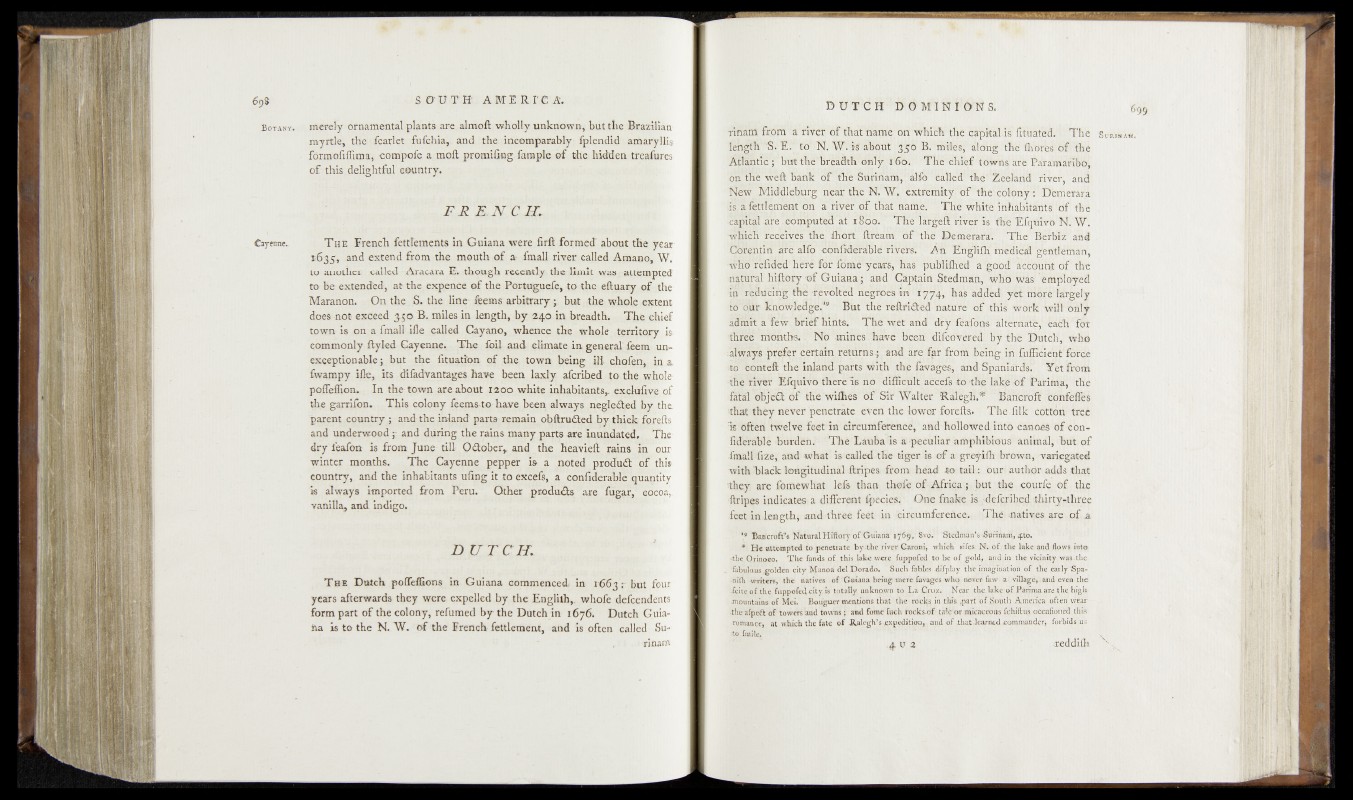
698 SOUTH' AMERIXA' .
Bo-mny. merely ornamental plants are alrnoft wholly unknown, but the Brazilian
myrtle* tfieKfeariet: dfufqhia* and the inc®mj®rably-
formofiffima, compofe a.moft promiflng fauaple ef the hidden treasures
of this, delightful eountry. tag
F R K JS0Q H I
Cayenne- T he French fettrements in Guiana were firft formed" about the year
*635, and extend from the mouth o f a? fmall riycr .called Amano,. W.
to another called -Aracara E. though recently thelimit was -attempted
to be extended, at the expence o f the Portijgnefe, tO the eftyary of-foe
Maranon. On the S. the line' feems arbitrary^ but -the whole extent
does not exceed 3.59 B. miles in length, by 240 in breadth. The A ie f
town is on; a fmall ifle called Cayano, whence thewhole territory is;
commonly ftyled Cayenne. The foil and elin^te mgeneral ieem ,unexceptionable;
but the fituation o f the town being iB chofenj in a
fwampy ifle, its difadVantages haw been laxly afcribed to the wipfe
pofleflion. In the town are about 1200 white inhabitants^ exchifivjU of
foe garrifon. This colony feems to have been always negle^ed by the
parent country j, and the inland parts remain ob^ru^ed by thicl| iprgfts
and underwood ^ and during the rains many parts are inyiylated^BHie
dry leafon is from June- till Qdiober^ and the heayieu rains In gbqr
winter months. The Cayenne pepper is a noted product o f this
country, and the inhabitants ufiag it to excefs, .a confiderable q-uahtity
is always imported from Peru. Other products age. ~ fugar,slocoa,
vanilla, and indigo.
D XTT C H .
T he Dutch pofleffions in Guiana commenced in 1663 r Bat four
years afterwards they were expelled by the Englilh,, whole defcendents
form part of the colony, refumed b y the Dutch in 1676» Dutch Guiana
is to the N. "W. o f the French fettlement, and is often called Surf;
,b$3&am
D U T CH D 0 M I U I O ïl ffl
rinam fröm a river^'that’tfame onf‘which the capital is" fftuated. The
length ,,JS. E W.'fs1 afb'odt B. "üi'ôikè of the
Àjmmtlîy but- thë’bréaâth 'only’ i'6'ô. The chi'ef to'v^iisarë Para'maribô,
ifipthe weft Barilf of The Surinam,' alio '’called' &é’ aeepuyFftver,' ané
New .Midâléoürg' ne Mr* the N. \Ÿ.l extremity of* thetcmany'-T Demerara
.is,a l^ttl^ment'on a'rjverW; that nkfiie. ’ The white inMb'itfhts'1 Hr the
capital ire Jborpputed ‘at 1 ^ & r TheTargeft river is ’ffr^fqiSivb N. W.
wHich receives the Jhoft ftream. <5f the Deme’raræ. The ' 'and
Corenfin aie al^'<onfidéraBlé iiyers?'^; A;n‘’l?ngn^'hfe,dibal gentlëHiafn,
Wffo remled here for fome years, has’ .puMiïKèd a ’go oa of'the
natural hiftoyy -©f Guiana ; and Captain Sled map, who was 'empïdyed
ip rgducin^ the revolted negrôè's m ; i 77*4, has addqd: yii niêrè largely
to*oyr knowjeage.18 But the reftri&ey hafurP^f this wärt .will bnly
admit a‘few brief hints. The w'ét and dry ferons!^îiernaw,hmfe'fot
three months.. No mines have been 'diïcbvered' by fhê Dutch', who
always prefer certain retûrns^ and are %r ‘from feeing; ip Efficient forcé
•to tonteft the inland parts with thq lavages, and Spinifids. YetîftoiH
tfie river EfqhiVo there is no difficult access’ lb *the‘ lakêmï Parima, the
fatal dbjed of the'wifnes of Sir Walter Ralegn.* "Bancroft- tfoliféWés
that'they never penetrate even the lower forefts- The 'ftlk cotton- treè
fg bftefi tÉfeN® zest" in circumference, and holloWedfttto càùoeé ÖPCon-
fîdërablë »büfdih.- 2Thé Eànba is à »peculiarVräMtfUtyE 13 àüiifiâl; but ©f
fmalhfize, and what is called the tiger k of a grey ifh--brown, variegated
with black longitudinal ftripes ffom head to tail.: bur? author- adds that
fogy are fomewbat left- foe#, thc^fe o£?Afriga .^Jmt ,.tb£
%lg§s indicates' à differeèt‘^eciejSï’ Ope fnafe?
feet in length* and three feét .in
19 Bancroft’« îfaturalHiftorÿ of-Gu’iarii; l ‘f ô f , 8to.j ’ Stcljftiûn’s >8ärtrtaai, ^to.
* He attempted to pettetiate by the liter Garonij Whicäh. «ifeäl Hi of:the Jafcerfrtd flows intn
■ itjie. Qdno«o. The fends of. this lake were fuppofsd to o|| veld,. andMn the vjcinfofiwas.the
; 'fabuloitts^golden city Manoà del Dorado. Such fables difplay the imagination of the early' S|iW
«niflt writers, the natives of Gafeoa being-mere. fevagBs-wte neirer few a ; viflâgëji apd. even the
icitçof the fuppofeflcityis tptally unknown tô La Çruz. Hçir -the fekç-çtf.^nOEian îHîé the, high
•mountains of Met. Baligner mentions that the rocks in this ç arf 'of South America often wear
■ the afpeft of towers and towns ; end fome’fufeh tocks.öf tàlè ortthicàceon» fdhiÄiSvö^a^ohra fafö
romance, at which the fate of JUlegh’s-£xpefliti,OT,, and of -that.learnndotamàaâerj .forbids.»«
tte.fmile.